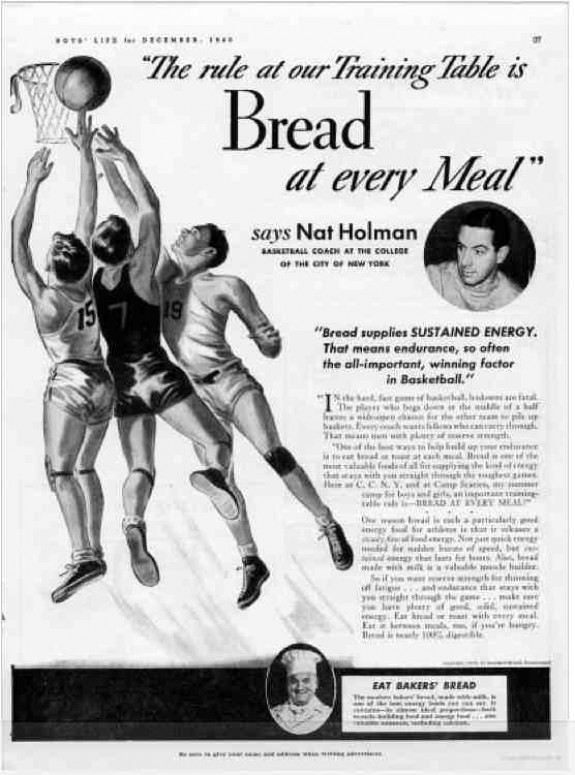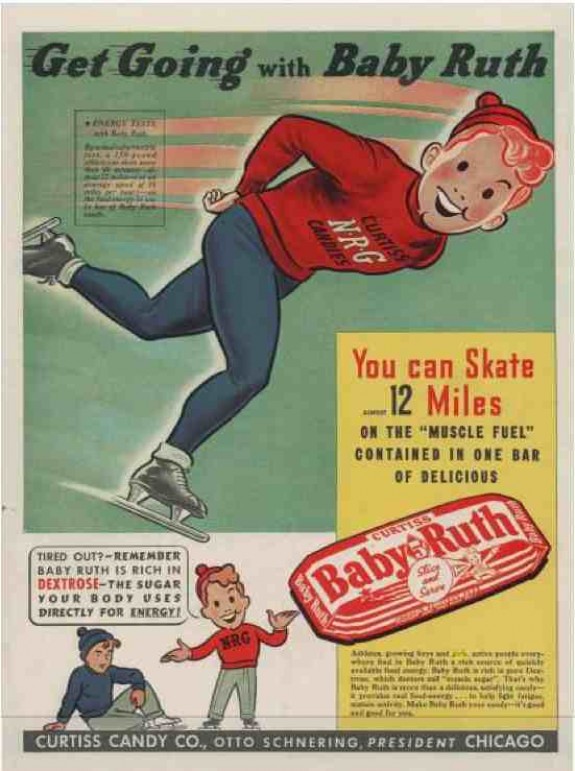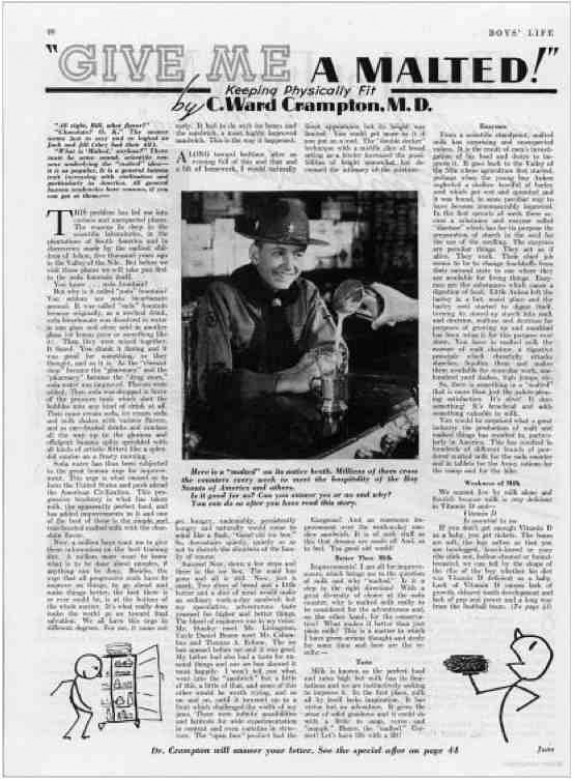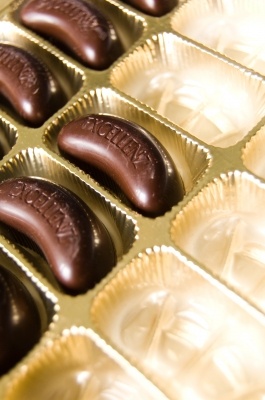Nutrition
The First Dog Whisperer
Much iconography that was once taken for granted as part of our culture now means nothing to people. Does any youth of today understand that a Napolean hat = crazy?
Posted By: Paul - Thu Feb 26, 2015 -
Comments (4)
Category: Anthropomorphism, Business, Advertising, Products, Food, Nutrition, Dogs, 1960s
Nutritionally Questionable Diets
Oddee gives us a list of diets that are most likely not nutritionist approved. The All Man-Juice Diet sounds interesting. It seems like it should be followed more strictly than described at the link though.
Posted By: Alex - Sat May 11, 2013 -
Comments (3)
Category: Nutrition
Nutritional Advice from BOYS’ LIFE



Posted By: Paul - Sun Sep 09, 2012 -
Comments (17)
Category: Magazines, Candy, Chocolate, Junk Food, Nutrition, 1930s, 1940s
The Benefits of Placentophagy
In a recent article in the journal Ecology of Food and Nutrition, Mark Kristal argues that placentophagia (that is, the eating of afterbirth or placenta) could offer significant benefits for humans — especially considering that all other mammals (including non-human primates) do it. (link: ScienceDaily.com). These benefits might include increasing mother-infant interaction, increasing the effects of pregnancy-mediated analgesia in the delivering mother, and potentiating opioid circuits in the maternal brain that facilitate the onset of caretaking behavior. He acknowledges that these possible benefits don't warrant "the wholesale ingestion of afterbirth," but he does think the issue deserves further study.The strange thing is that although all other mammals practice placentophagy, no human cultures do (according to Dr. Kristal) — except for Hollywood celebrities.
Posted By: Alex - Mon Apr 09, 2012 -
Comments (6)
Category: Babies, Food, Nutrition, Health
Follies of the Mad Men #178
My questions:
1) Did girls and women acquire those same Charles Atlas muscleman biceps shown on the box, or just boys and men?
2) Do they eat Pep on the International Space Station today?
3) Does anyone today still say, "He's got pep!" or "I feel peppy!"...?
And if you haven't had enough cereal trivia, please allow me to highly commend this new book, which is a lot of fun. My review will appear soon at THE BARNES & NOBLE REVIEW.
Posted By: Paul - Wed Mar 07, 2012 -
Comments (6)
Category: Business, Advertising, Products, Family, Food, Nutrition, Health, 1950s
Another Helping of Food Related Weirdness – 7

Meanwhile, here is someone who is taking the chocolate maker’s art way too literally. Jean Zaun of Fredericksburg in Pennsylvania uses a mixture of dark and white chocolate, food colouring and confectioner’s glaze to recreate famous works of art, including the frames, in a deliciously edible form. Her subjects have included the works of Van Gogh, Munch and Da Vinci, as well as a portrait of Ozzy Osborne commissioned by his wife. While the chocolate artworks are edible, Zaun believes they should be souvenirs rather than snacks. “They are meant to be consumed by the eye, not the stomach.” Zaun Explained (Daily Mail).
And the misuse of materials won’t stop there, at least not if Dr. Peter Eisner of the Fraunhofer Institute gets his way. Concerned that meat consumption is both unhealthy and bad for the environment, Dr. Eisner has started looking for ways to supplement or replace animal products with vegetable equivalents. His first success is a milk substitute derived from lupins that can even be used to make cheese, meanwhile co-worker Daniela Sussmann has extracted a protein from the seeds gives low-fat sausages more of the sensation of their unadulterated competition. Eisner reckons that our ever growing appetite for meat could one day be disastrous, arguing that the resources needed to produce 1 kilo of meat could instead yield 80 to 100 kilos of fruit or vegetables (Softpedia).
More in extended >>
Posted By: Dumbfounded - Mon Jan 10, 2011 -
Comments (7)
Category: Agriculture, Animals, Farming, Art, Food, Bacon, Candy, Junk Food, Nutrition, Vegetables
When Bacon Just Isn’t Enough
Now you can get your caffeine and protein in one, hard to chew, treat. Meet Perky Jerky; where the meat treat meets the morning cuppa joe.
Posted By: Expat47 - Wed Feb 17, 2010 -
Comments (6)
Category: Nutrition
Another Helping of Food Related Weirdness - 5

This year also marks the 20th anniversary of the coming down of the Berlin Wall, so what better way to celebrate than by building a new one, out of chocolate. Patrick Roger, a chocolatier from Paris France, decided to commemorate the historic reunification of East and West Germany by building a 15m long replica of the wall out of 900 kg of chocolate, complete with uncanny reproductions of the spray painted graffiti made with coloured cocoa butter. The chocolate wall was later "torn down" and broken up on November 9th, exactly 20 years after the original (ChocoParis).
And this isn’t the only feat of chocolate engineering in recent weeks. The “New World Whakatane” Bakery, from Australia's "baby brother" New Zealand, set a Guinness World Record this month for baking the world’s largest chocolate log. At over 35 metres in length and weighing in at nearly 78 kilos, the confectionary monster smashed the previous record of a measly 10 metres, but fell short of the 50 metres they had hoped for. Once the new record had been verified, the log was cut into slices and sold to raise money for a teenage cancer charity (TVNZ).
Still more gargantuan grub now as hundreds of students from the University of California at Berkeley became sushi chefs for a day by helping to roll a 330 foot “California roll” to celebrate the 50th anniversary of UoC’s Center for Japanese Studies. The sushi roll broke the previous record of 300 feet, and contained 200 lbs of rice and 180 lbs of fish, the last 15 feet was made with tofu for the benefit of attending vegetarians (Boston Herald).
More in extended >>
Posted By: Dumbfounded - Fri Nov 20, 2009 -
Comments (3)
Category: Anniversary, Awards, Prizes, Competitions and Contests, Education, Food, Nutrition, Inebriation and Intoxicants, Historical Figure
Chocolate Just Got Better!

FYI: Chocolate was, as everyone knows, invented/discovered by the Aztecs. But what is less well known is that they did so at least 3000 years ago, and were probably trying to make beer. Anthropologists John Henderson, of Cornell University, and Rosemary Joyce, of University of California, discovered cacao residues on pottery vessels dating back to 1000 BCE that are believed to be from a drink formed by fermenting the pulp and seeds (PNAS).
(Image by Wikipedia.)
Posted By: Dumbfounded - Fri Jul 17, 2009 -
Comments (20)
Category: Food, Candy, Nutrition, History, Archaeology, Products
Some More Food Related Weirdness
Returning to a topic close to my heart (well, the cholesterol is at any rate), I'd like to start this food of the weird round-up with an intriguing piece of recent research that chocolate milk may, in fact, be a better "sports drink" than many sports drinks. In trials conducted by scientists from James Madison University on thirteen college football players, low-fat chocolate milk outperformed commercial high-carbohydrate recovery drinks, with tests showing lower levels of kinases associated with muscle strain. Though equally effective as a training aid, chocolate milk is unlikely to replace sideline "energy" drinks like Gatorade anytime soon. Which is a pity, if nothing else, a switch to chocolate milk would enliven the coach's traditional "post-game shower" (Net Doctor).Of course, the athletic benefits of chocolate could only be improved by adding a protein supplement, right? Well not if, as alleged by one Tampa Bay business, that extra protein came in the form of an infestation of moths. Wholesaler "Mar-Len Confections" and retailer "Chocolates by Michelle" are currently suing one another over the fate of a shipment of $4500 worth of chocolate supplied by the former. According to Michelle Palisi, owner of the eponymous business, the chocolate was contaminated with live moths, meaning she not only had to throw out the shipment and replace it, but also had to hire an exterminator to eradicate the moths and clean the building. Wes Niedecken, owner of Mar-Len, disputes this, blaming poor pest control on the part of Palisi. The moths themselves are not unusual, and candy - especially chocolate - is a particular favourite of caterpillars. Fortunately for the consumer, the FDA has strict rules in place... no more than 60 insect parts per 100 grams of chocolate (St. Petersburg Times).
Also coming up for a food related day in court is NC teen John Szwalla, who tried to hold up a convenience store... with a banana. The 17 year-old, now facing charges of attempted armed robbery, initially told staff at the Winston-Salem store that he had a gun, though the truth quickly became apparent when owner Bobby Rae Mabe and a customer managed to jump Szwalla and pin him to a chair. The would-be robber then tried to dispose of the evidence by, you guessed it, eating the banana. He was unable to dispose of the peel however and police later took it away as evidence. Recalling his harrowing experience Mabe said, "If he had had a gun he would've shot me, but he had a banana" (Sky News).
But while the humble banana might not be the weapon of choice, it can still make you money. At least, that's what banks in Davao in the Philippines think. Fresh from the success of sub-prime mortgages, banks are apparently eyeing banana plantations as the next big growth sector. One local bank plans to double its $27 million investment in bananas by the end of the year, citing growing demand. Said bank president Alex Buenaventura, "Banana has become the fabled duck that lays golden eggs" (Business Mirror).
While it's easy to mock, perhaps Mr. Buenaventura enthusiasm mightn't be quite the joke it first appears. Banana imports to Japan have leapt over 25% in just a few months on the back of a new diet craze, the "Morning Banana" diet. Initially aired on a social networking site, this new fad has already spawned four bestselling books and a raft of TV endorsements, with public and celebrities alike lining up to show off their new - banana-induced - bodies. As for the diet, it is simplicity itself, just eat bananas for breakfast, and nothing else, then enjoy whatever you want for lunch and dinner (Inventor Spot).
More in extended >>
Posted By: Dumbfounded - Wed Jun 03, 2009 -
Comments (6)
Category: Exercise and Fitness, Fads, Science, Sports, Stupid Criminals, Nutrition, Bananas

| Who We Are |
|---|
| Alex Boese Alex is the creator and curator of the Museum of Hoaxes. He's also the author of various weird, non-fiction, science-themed books such as Elephants on Acid and Psychedelic Apes. Paul Di Filippo Paul has been paid to put weird ideas into fictional form for over thirty years, in his career as a noted science fiction writer. He has recently begun blogging on many curious topics with three fellow writers at The Inferior 4+1. Contact Us |




